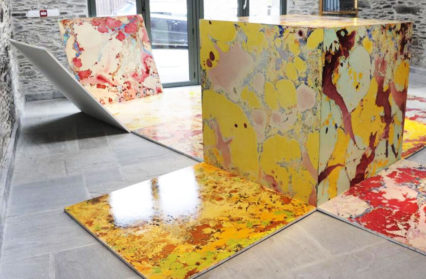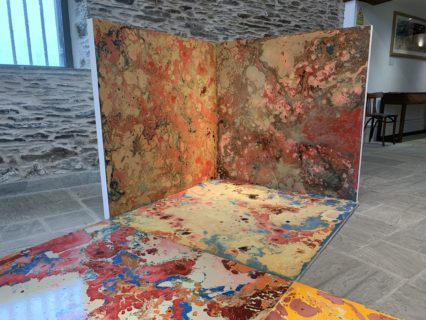Candy Bedworth writes on Assemblage by Colin Williams, currently showing at MOMA Machynlleth, with a review of the exhibition followed by a conversation with the artist.
Approaching the sculpture space in MOMA Machynlleth, our first encounter with Colin Williams’ Assemblage is a view of the white painted backside of the piece. It must be intentional, but it throws us, the viewer, at least for a moment. This is the artist showing us the raw materials, the guts of his work. This is just timber and white paint – isn’t it?
But continue on in to the space, and spend a moment with the work, and then comes the dopamine hit. In plain descriptive terms, this is a 3D installation of painted square panels. Each panel is marbled, each is different: from brilliant cadmiums of scarlet, ochre, yellow, and orange, through to teal and chlorophyll green. We see abstract shapes that evokes images from the surface of Mars to a sunlit meadow to a juicy steak – it’s all here.
Some of the panels are laid out flat, some are built into box shapes. Weirdly, we get the impression of movement – and very recent movement at that. Have the blocks been left for a moment, mid construction? Has Colin just popped out? Will someone return to turn, build and reshape them? And to add to the dizzying effect, our sense of scale has gone to pot. Our logical brain states that these are large boxes in a small room. But look up to that vast roof space above, and both we and the boxes are tiny. Or are we huge? Because these are like scattered children’s playblocks – maybe we could pick one up and start a tower.
I confess, writing about abstract art and installations can be problematic. The artist has already said all they have to say in the space, with the work. But what if we don’t get it? Whose fault is that? And sometimes we get it, but we are left to fumble for descriptions and allegories in order to share our response. Will we limit this exhibition with description? The big question, of course, is: what is this? Is it a painting, a sculpture or an installation? Colin Williams assures us it is all three, asking us to consider “the nature of art as transformable and in flux.”
Born in 1963, Colin Williams grew up in Llandudno and lived there for most of his life. He studied Fine Art at the University of Ulster, in Belfast gaining a BA and an MA. He later spent time on artist residencies in the USA and now lives full-time in New York. Colin Williams says that his work engages with the visual tension of opposites and contradictions, and examines the relationship between colour, shape and form.
In an on-going relationship with the square blocks and what they might mean, Colin Williams has dismantled and then reassembled these components over different locations, in varying formations. The layout we see at MOMA Machynlleth has been created specifically for the exhibition and sculpture space. But these squares have done some mileage: starting at Mostyn Gallery, Llandudno, then exhibited at the Context Gallery in Derry, Northern Ireland. And now back in Machynlleth until November 2022.
Speaking about the MOMA exhibition, Colin Williams has said:
“It not only explores the unfolding sequences that can be produced out of one given shape, in contrast to the complexity of colour on the installations surface, but also plays with its slippage between the concepts of Painting and Sculpture, Construction and Deconstruction, Symmetry and Asymmetry, Minimalism and Maximalism.”
This is art constantly moving: expanding and contracting, contradicting then reconciling. As someone who might have been (in another life) an archaeologist or a builder, Colin Williams is working and reworking the themes that inspire him. As he said when we spoke recently: “think of the work as a deck of playing cards, where you can shuffle the single cards into numerous unfolding sequences to form a new hand, or hands.”
Hmm, but now our art bullshit radar has been alerted – are we being sold a dud? Maybe this is just the same furniture being moved around a small room in a desperate attempt to make it look bigger, fancier, lovelier. Or are we being reminded that we all have just a handful of ‘materials’ to work with: our basic gene building blocks, our personality, our childhood, our passions and our traumas. And we endlessly rearrange these blocks to amuse ourselves and others. In the end isn’t that all any of us have?
After viewing the exhibition we had the opportunity to ask Colin Williams about his life and plans for the future:
Candy Bedworth: What do you want the viewer to see/feel when they engage with your art?
Colin Williams: In particular, with Assemblage, I want the viewer to see something that slips between a 3-Dimensional Painting, and an Optical Sculpture. And I want the viewer to think about the function, and nature of art as transformable and in flux. With all my work, I want to cultivate playful cognition and imagination, and encourage experimentation.
Candy Bedworth: What prompted your move to live permanently in New York? How often do you return to Wales?
Colin Williams: I moved to the USA to marry my fiancée. Initially, my wife and I were living in rural Wisconsin, in a farmhouse on three and a half acres of land. My wife and I run our own cottage industry, producing hand-made eco-friendly fire-lighters.
We enjoyed our time there immensely, and had no plan on leaving. The notion of moving followed a trip we took to see my wife Mary’s family, in New Jersey. Whilst there, we made a trip up the Hudson Valley, in New York State. We both fell immediately in love with this area and all it had to offer. The landscape in parts, was reminiscent of Betws-Y-Coed, in the Conwy Valley, North Wales. We discovered that there were lots of visual artists and musicians here, and it was within striking distance of New York City, and its wealth of art galleries and opportunities.
We are just over an hour away from a small international airport, which is so convenient. I fly from here to Liverpool, which is just over an hour away from my hometown of Llandudno, and I return to Wales twice a year, for at least a month each trip.
Candy Bedworth: How do you see the Welsh landscape (both physical & cultural) affecting your work, or contributing to it?
Colin Williams: Initially, my early works were measured, and determined, but as I regularly sailed between Ireland and Wales in the late 1990’s / early 2000’s, I became increasingly occupied with the ever changing structure of the Welsh coastline; contemplating how it is continually being shaped by the undulating sea, whose tides are controlled by the moon, which in turn is controlled by the universal forces of gravity.
These thoughts inspired me to create a large body of work, entitled Geography of Thought. This series of paintings grew from my travels back and forth to Wales, and my interests in both the ancient theory of the Golden Section, (also known as the Divine Proportion) which was thought to possess some hidden harmonic proportion in tune with the universe, and the post-modern Chaos Theory: an unpredictable world, which reacts to chance events that occur within it.
Subsequently, I explored the unfolding sequences that can be produced through the reiteration of a coastline, in an attempt to reconstruct an alternative account of the landscape, where the composition of the paintings and the nature of their construction, identified more with the Geography of Thought.
In cultural terms, in later work, I began playing with the design of the Welsh flag, recasting its various elements and colours into playful juxtapositions with simplified castle shapes. Ironically, some of these emblematic interactions reminded me of the popular video game, ‘Space Invaders’! Consequently, I engaged with the visual language of that to explore the cultural memory of Wales, through the lens of colonization. However, the remit of this work extends beyond any account of past conflicts and civil unrest. It engages more with the concerns of a post-conflict and bi-lateral society, that is, complications pertaining to Identity, Language, and Geopolitical control.
Candy Bedworth: Where do you work? Do you have a separate studio?
Colin Williams: My work always takes place in a studio. Since moving to New York State, I have had to work in an offsite studio for 18 months, but I am happy that we have just closed on the house next door, which has a studio on the top floor.
Candy Bedworth: Whose art are you excited by (past or present)?
Colin Williams: Victor Pasmore (and his belief that art should emanate from nature, not imitate it), Morris Louis, Agness Martin, Sol LeWitt, Jim Lambie, to name but a few.
Candy Bedworth: And finally, what next for Colin Williams?
Colin Williams: I am working on a new body of work that evolved from a previous body of work, which was titled Waves & Particles. This new body of work visually expands on these ideas. I feel a sense of achievement when an artwork is finally finished, and keen to get it shown, but a little anxious of how it will be received by the outside world!
Assemblage is now part of the MOMA Machynlleth permanent collection. It will be exhibited until 5th November 2022.













